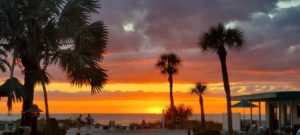
Yes, I realize that most people sitting along a Florida shore while idly gazing upon the Gulf of Mexico might have other thoughts on their mind – dinner plans perhaps, where one might venture on tomorrow’s fishing excursion, who might be conscripted to go fetch another glass of wine. But I must confess. My world, to paraphrase SNL’s Unfrozen Caveman Lawyer character, is more often than not a strange one and much prone to wandering off into the fantastical.
But what a wonderful evening it is! By the reckoning, of my raised hand, sunset is about 45 minutes away. Low on the western horizon and now obscured by cloud, the muted orb has turned the brilliant, azure water of this afternoon into a dark, leaden gray. The clouds themselves are now beginning to transmute themselves into a glorious array of oranges, yellows, reds, and violets. It looks to be yet another breathtakingly gorgeous sunset in this paradisiacal little corner of the world. A gentle breeze wafts in from the sea carrying with it that strange, indecipherable odor born of saltwater, fish, clam, and the other cryptic elements lurking out there in the deep. I am mindful and acknowledge my good fortune in being able to sit here, pinot noir in hand, granted the time and means to do so by a benevolent Grace.
Modest waves lap the shoreline before me. Doubtless, on this particular evening, there are many others along this shore who share the calming, meditative effect of this endless surf. How many times has this beach been struck by the incoming waves over the past hours, days, millennia? There is a feeling of timelessness about the sea; so mystifying it is, so vast, the bearer of so many secrets. How could one sit here and not be mesmerized?
Along the shoreline spread before me, marches a procession of avian actors. 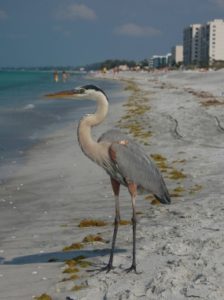 Sanderlings, ruddy turnstones, and willets are the main participants in this evening’s entertaining parade. Earlier a stately great blue heron joined the crowd. The heron lazily hunted by locating a surf fisherman and loafing nearby patiently awaiting a handout. Offshore brown pelicans and common terns are joined by cormorants and the occasional osprey, all actively searching for a fishy dinner. All in all, it is a lovely tableau in which I am privileged to find myself immersed.
Sanderlings, ruddy turnstones, and willets are the main participants in this evening’s entertaining parade. Earlier a stately great blue heron joined the crowd. The heron lazily hunted by locating a surf fisherman and loafing nearby patiently awaiting a handout. Offshore brown pelicans and common terns are joined by cormorants and the occasional osprey, all actively searching for a fishy dinner. All in all, it is a lovely tableau in which I am privileged to find myself immersed.
Longboat Key is indeed a heavenly spot for removing oneself from the rigors of a cold, mirthless, muddy Indiana winter. Having come here to 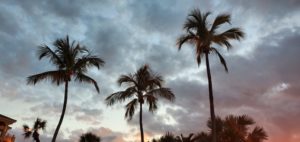 achieve this escape for 20 years now, the place is as familiar and cozy as well-worn slippers. Longboat Key is lovely beyond imagining. Gulf of Mexico Drive, the main byway, is landscaped with what seems to be every species of palm known to man. There are royal palms, Canary Island date palms, traveler’s palms, silver palms, cabbage palms, and coconut palms. Each has its characteristically identifiable leaf or trunk pattern. Adjacent lawns are flawlessly groomed, their bordering hedges of sea grape dutifully watered by automated irrigation systems. Upon the street itself one will find nothing to mar the loveliness of the place. No gum wrappers, no cigarette butts, no thoughtlessly tossed aluminum cans are allowed to disgrace the thoroughfare’s manicured elegance.
achieve this escape for 20 years now, the place is as familiar and cozy as well-worn slippers. Longboat Key is lovely beyond imagining. Gulf of Mexico Drive, the main byway, is landscaped with what seems to be every species of palm known to man. There are royal palms, Canary Island date palms, traveler’s palms, silver palms, cabbage palms, and coconut palms. Each has its characteristically identifiable leaf or trunk pattern. Adjacent lawns are flawlessly groomed, their bordering hedges of sea grape dutifully watered by automated irrigation systems. Upon the street itself one will find nothing to mar the loveliness of the place. No gum wrappers, no cigarette butts, no thoughtlessly tossed aluminum cans are allowed to disgrace the thoroughfare’s manicured elegance.
The municipality has thoughtfully provided bike paths and sidewalks along this main street. They are busy morning to night with riders, walkers, 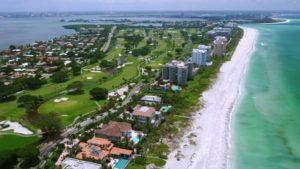 canine companions, and rollerbladers. Golfers navigate the elegantly landscaped layouts of the Longboat Key Club. The layout’s fairways are delineated by gracefully arching palms and live oaks, the greens protected by artistically placed traps of brilliant white sand. These are meant to attract the eye as well as the errant shot. There are parks where one may bird, fish, play tennis or pickleball, picnic, or otherwise while away the day in pursuit of fitness, an abiding calm, or a lovely view. Restaurants beckon one to sit under the stately palms and enjoy the singularly delicious, freshly-cut seafood for which Florida is famous. Yes, all in all, there is little doubt as to why I look forward to a yearly escape to this little piece of paradise.
canine companions, and rollerbladers. Golfers navigate the elegantly landscaped layouts of the Longboat Key Club. The layout’s fairways are delineated by gracefully arching palms and live oaks, the greens protected by artistically placed traps of brilliant white sand. These are meant to attract the eye as well as the errant shot. There are parks where one may bird, fish, play tennis or pickleball, picnic, or otherwise while away the day in pursuit of fitness, an abiding calm, or a lovely view. Restaurants beckon one to sit under the stately palms and enjoy the singularly delicious, freshly-cut seafood for which Florida is famous. Yes, all in all, there is little doubt as to why I look forward to a yearly escape to this little piece of paradise.
But, as I have described, the Key is a place where the mind has time to work too. This evening I find my thoughts becoming troubled. I cannot help but recognize that Longboat Key, and its neighboring islets, are perfect examples of the human ability to drastically modify the natural world to suit our desires. Our species is quite clever, there is no doubt. But this cleverness coupled with that power to transform the earth has had extremely dire consequences. Moving with the inertia of a ponderous glacier, our incessant desire for development and “progress” has transfigured the natural world I cherish. And thus the Fermi Paradox suddenly comes to mind.
In 1950, physicist Enrico Fermi was discussing recent UFO reports with some colleagues. Naturally, their conversation turned to the possibility of extraterrestrial, intelligent life forms. Given that the Universe contains 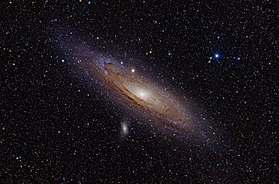 billions of galaxies each with further hundreds of billions of stars, they thought it highly likely that many of these stars were orbited by planets (an observation now being confirmed in the 21st century). Agreeing that many of these stars and planets were much, much older than our solar system, the scientists speculated it likely that intelligent, technologically advanced life may have already developed elsewhere in the Universe.
billions of galaxies each with further hundreds of billions of stars, they thought it highly likely that many of these stars were orbited by planets (an observation now being confirmed in the 21st century). Agreeing that many of these stars and planets were much, much older than our solar system, the scientists speculated it likely that intelligent, technologically advanced life may have already developed elsewhere in the Universe.
Such intelligent ET’s would have had sufficient time to develop intergalactic space travel (Even now, here on Earth, we are beginning to dip our toes into the celestial seas). Thus, there should have been plenty of time for these advanced life forms, or their probes, to have visited Earth. At this point in the conversation Fermi asked the big question: If all this is true where are they? In other words, isn’t it paradoxical for the Universe to contain scores of advanced civilizations and for us to have received no form of evidence of the fact?
Fermi’s question was a good one and it has subsequently yielded many possible answers. Maybe any form of extraterrestrial life is extremely rare, perhaps even nonexistent. It is possible that intelligent life is even more rare or has not evolved at all. Could it be that natural events, similar to earth’s Chicxulub Asteroid, periodically erase life from other planets before advanced intelligence and technology have a chance to germinate? Maybe the intelligent life forms inhabiting other worlds simply haven’t developed the engineering science needed for long distance, long-term travel to other parts of the Universe. There are many other hypothetical answers to this question.
But it is one particular speculation regarding this absence of evidence that is a worrisome occupant of my thoughts as I lounge upon these golden sands this evening. It has also been suggested that we have had no evidence of extraterrestrial, intelligent, technologically advanced civilizations simply because such societies tend to eliminate themselves from existence. They do so long before they develop the ability to travel to other star systems. The suggested means of such self-destruction are many: global nuclear war, natural resource depletion, overpopulation leading to rapid transmission of an untreatable pandemic disease, technologically induced catastrophic climate change. Ill-conceived and eventually harmful advances in biotechnology or artificial intelligence or accidental environmental contamination on a global scale are other possibilities. Some of these possibilities sound eerily familiar don’t they?
The late Sebastian van Hoerner, a physicist, believed that human progress on earth was driven by the combination of a desire for domination and our want of an easy life. We need only look to history in order to verify the human proclivity for dominating other races, nationalities, or ethnic groups outside our own; whatever that may be. My little barrier island paradise – once covered by mangrove, live oak, gumbo limbo, and red cedar – also seems a frighteningly accurate snapshot of our incessant commitment to the domination of nature as well. Residing here would certainly seem to fit van Hoerner’s image of the life of comfort.
Unfortunately the results of our inventive march to what we perceive as progress have, during just my lifetime, come to rear their ugly heads. More than seventy-five percent of the earth’s land surfaces have been altered 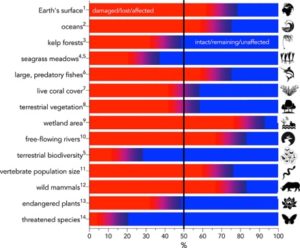 significantly by human works (www.nationalgeographic.com). The next time you are up in an airplane notice, as you look downward, how difficult it is to find a piece of land that does not bear some mark of human works. Over 1000 documented species extinctions have occurred in the last 500 years. Another one million plant and animal species are under threat of extinction today. Eighty-five percent of global wetlands have been lost in the past three centuries. Science warns that we are on the verge of a so-called “insect apocalypse”; an event some might unthinkingly hail but which, in reality, would be devastating for earth’s ecosystems (as well as human agriculture). Fifty percent of living coral reefs have disappeared in the past two centuries*. Seventy to eighty percent of the world’s fisheries are at maximum usage and on the verge of collapse. Plastic waste equivalent to a
significantly by human works (www.nationalgeographic.com). The next time you are up in an airplane notice, as you look downward, how difficult it is to find a piece of land that does not bear some mark of human works. Over 1000 documented species extinctions have occurred in the last 500 years. Another one million plant and animal species are under threat of extinction today. Eighty-five percent of global wetlands have been lost in the past three centuries. Science warns that we are on the verge of a so-called “insect apocalypse”; an event some might unthinkingly hail but which, in reality, would be devastating for earth’s ecosystems (as well as human agriculture). Fifty percent of living coral reefs have disappeared in the past two centuries*. Seventy to eighty percent of the world’s fisheries are at maximum usage and on the verge of collapse. Plastic waste equivalent to a 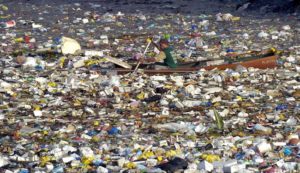 garbage truck dumped every minute has made its way into the world’s oceans**. The resultant breakdown of such material yields microplastics. These have already entered food chains having humans at the top trophic level.
garbage truck dumped every minute has made its way into the world’s oceans**. The resultant breakdown of such material yields microplastics. These have already entered food chains having humans at the top trophic level.
It is quite possible that my great-grandchildren will be able to enjoy the coastal Florida I have known only by one day cruising above it in a boat. 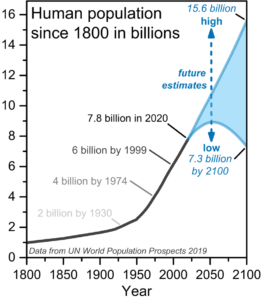 Earth’s human population is approaching eight billion, more than double the number it was when I graduated from high school five decades ago. It is projected to reach ten billion by the year 2050. Surely it is irrational to believe that standing room only is a workable, future possibility. This ecological overshoot of the human population is at the heart of the environmental problems which now plague us. These are the by-products of the biotic potential and insidious cleverness of our species.
Earth’s human population is approaching eight billion, more than double the number it was when I graduated from high school five decades ago. It is projected to reach ten billion by the year 2050. Surely it is irrational to believe that standing room only is a workable, future possibility. This ecological overshoot of the human population is at the heart of the environmental problems which now plague us. These are the by-products of the biotic potential and insidious cleverness of our species.
My point is this. The catalog of environmental ills affecting our planet (and I haven’t even mentioned the societal dysfunctions we see now) seem disturbingly familiar. Do they not sound much like one of the conjectural answers to the Fermi Paradox? Are not the environmental problems we face now much like those speculated upon as mechanisms whereby an alien civilization might radically alter or even eliminate itself? Could this hypothesis, so abstract at its foundation, really be a concrete warning that we need to change course here on our home world?
And so, perhaps, you may discern why my ruminations are uneasy in spite of my lovely surroundings. But here is the thing that is most worrisome to me. Regardless of my life-long love of wild things and wild places, irrespective of my sense of looming catastrophe, I really like it here in this little artificial world. For all the reasons I have given you, I find Longboat Key a place of serenity, loveliness, and relaxation. In spite of my awareness of the dependence of human kind upon maintaining the health of our natural world, I look forward to my yearly visits to this little, man-made Eden.
So, I am left to ponder. Can we, as a civilization continue to develop and enjoy indulgences such as this tiny key without irreparable harm to our planet? Are we on the verge of irreversible environmental damage born of our own too much? Is it simply through seeking a life marked by technological progress and added comfort – simply by living – that we might eventually trigger a cascade of ill-effects which could doom human society?
I believe the answers to these questions are known. Undoubtedly there are ways in which we might sustainably relieve the stress human society places upon our only planetary home. The real question is: do we have the foresight, good sense, and willpower to do so?
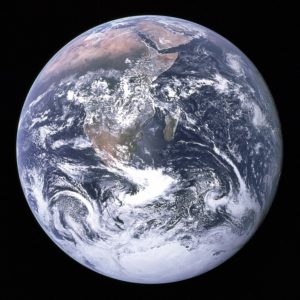
____________________________________________
*Underestimating the Challenges of Avoiding a Ghastly Future. Frontiers in Conservation Science. January, 2021. Bradshaw et. Al.
**seasave.org/plastic-pollution
Photo Credits:
Longboat Key aerial at wwwvisitflorida.com
the Andromeda Galaxy at wikimediacommons.org
biodiversity loss chart at wikiwand.com
ocean plastic pollution at pri.org
human population graph by Bdm at wikimediacommons.org
all other photos by the author
